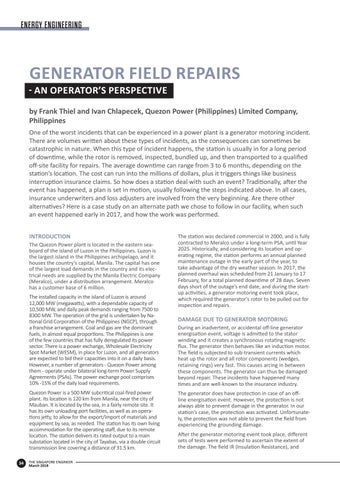ENERGY ENGINEERING
GENERATOR FIELD REPAIRS AN OPERATOR’S PERSPECTIVE by Frank Thiel and Ivan Chlapecek, Quezon Power (Philippines) Limited Company, Philippines One of the worst incidents that can be experienced in a power plant is a generator motoring incident. There are volumes wri en about these types of incidents, as the consequences can some mes be catastrophic in nature. When this type of incident happens, the sta on is usually in for a long period of down me, while the rotor is removed, inspected, bundled up, and then transported to a qualified off-site facility for repairs. The average down me can range from 3 to 6 months, depending on the sta on’s loca on. The cost can run into the millions of dollars, plus it triggers things like business interrup on insurance claims. So how does a sta on deal with such an event? Tradi onally, a er the event has happened, a plan is set in mo on, usually following the steps indicated above. In all cases, insurance underwriters and loss adjusters are involved from the very beginning. Are there other alterna ves? Here is a case study on an alternate path we chose to follow in our facility, when such an event happened early in 2017, and how the work was performed. INTRODUCTION The Quezon Power plant is located in the eastern seaboard of the island of Luzon in the Philippines. Luzon is the largest island in the Philippines archipelago, and it houses the country’s capital, Manila. The capital has one of the largest load demands in the country and its electrical needs are supplied by the Manila Electric Company (Meralco), under a distribu on arrangement. Meralco has a customer base of 6 million. The installed capacity in the island of Luzon is around 12,000 MW (megawa s), with a dependable capacity of 10,500 MW, and daily peak demands ranging from 7500 to 8300 MW. The opera on of the grid is undertaken by Naonal Grid Corpora on of the Philippines (NGCP), through a franchise arrangement. Coal and gas are the dominant fuels, in almost equal propor ons. The Philippines is one of the few countries that has fully deregulated its power sector. There is a power exchange, Wholesale Electricity Spot Market (WESM), in place for Luzon, and all generators are expected to bid their capaci es into it on a daily basis. However, a number of generators - Quezon Power among them - operate under bilateral long-term Power Supply Agreements (PSAs). The power exchange pool comprises 10% -15% of the daily load requirements. Quezon Power is a 500 MW subcri cal coal-fired power plant. Its loca on is 120 km from Manila, near the city of Mauban. It is located by the sea, in a fairly remote site. It has its own unloading port facili es, as well as an operaons je y, to allow for the export/import of materials and equipment by sea, as needed. The sta on has its own living accommoda on for the opera ng staff, due to its remote loca on. The sta on delivers its rated output to a main substa on located in the city of Tayabas, via a double circuit transmission line covering a distance of 31.5 km. 34
THE SINGAPORE ENGINEER March 2018
The sta on was declared commercial in 2000, and is fully contracted to Meralco under a long-term PSA, un l Year 2025. Historically, and considering its loca on and opera ng regime, the sta on performs an annual planned maintenance outage in the early part of the year, to take advantage of the dry weather season. In 2017, the planned overhaul was scheduled from 21 January to 17 February, for a total planned down me of 28 days. Seven days short of the outage’s end date, and during the startup ac vi es, a generator motoring event took place, which required the generator’s rotor to be pulled out for inspec on and repairs.
DAMAGE DUE TO GENERATOR MOTORING During an inadvertent, or accidental off-line generator energisa on event, voltage is admi ed to the stator winding and it creates a synchronous rota ng magne c flux. The generator then behaves like an induc on motor. The field is subjected to sub-transient currents which heat up the rotor and all rotor components (wedges, retaining rings) very fast. This causes arcing in between these components. The generator can thus be damaged beyond repair. These incidents have happened many mes and are well-known to the insurance industry. The generator does have protec on in case of an offline energisa on event. However, the protec on is not always able to prevent damage in the generator. In our sta on’s case, the protec on was ac vated. Unfortunately, the protec on was not able to prevent the field from experiencing the grounding damage. A er the generator motoring event took place, different sets of tests were performed to ascertain the extent of the damage. The field IR (Insula on Resistance), and
